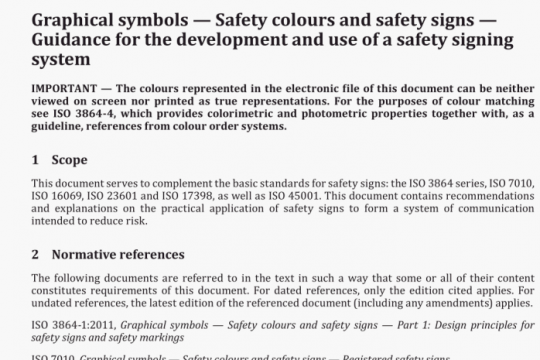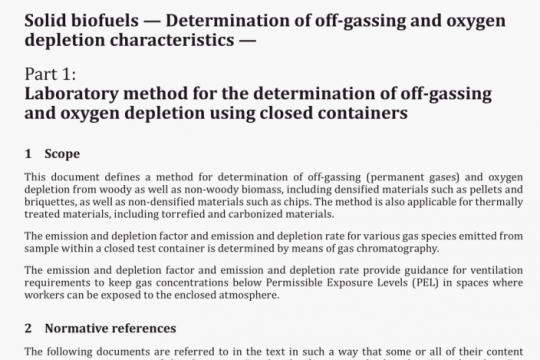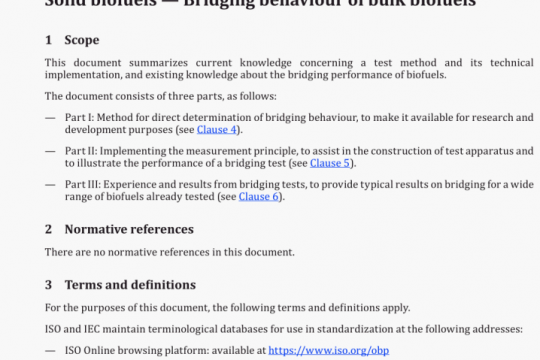ISO 22185-1 pdf free download
ISO 22185-1-2021 pdf free download.Diagnosing moisture damage in buildings and implementing countermeasures一 Part 1: Principles, nomenclature and moisture transport mechanisms.
7.6 Creaking
Increased noise or abnormal sounds generated by materials affected by change in moisture content. Doors, sliding doors, etc. do not open or roll smoothly, making gnawing or abnormal sounds. This is caused by deformation due to expansion or shrinkage of materials. In addition, the exterior material sometimes makes an abnormal sound due to expansion or shrinkage caused by temperature change.
Related terms: shrinkage, low humidity, expansion, high humidity, deformation, warpage.
7.7 Deformation
Change in the shape of an object due to stress from expansion or shrinkage.
Related terms: expansion, high humidity, shrinkage, low humidity, warpage, floating.
7.8 Dissolved destructive elements
Water transport of dissolved, destructive elements (e.g. salt, acid rain) which cause accelerated deterioration of building materials.
Related term: corrosion (electrolytic) of metal.
7.9 Dissolution
Refers to various materials where the performance is compromised due to water activity or moisture. In this document, it refers to materials that re-emulsify when in prolonged contact with water.
Related term: wetting.
7.10 Expansion
Increase dimension or volume of an object. This is due to physicochemical causes such as rise in temperature and humidity. In this document, this term mainly means that the volume of porous materials increases due to moisture absorption. Also, when moisture inside a material freezes, expansion occurs.
Related terms: high humidity, wetting, freezing, swelling, thrust up.
7.11 Floating
This means that a bonded surface, or a coated overlaid surface, disengages. For example, mortars applied to a concrete substrate or plastered foundation layers and tiles delaminate due to drying and shrinkage. This is also known as skin separation. It is also an indication of a state in which the inside of the material expands due to frost damage, peeling occurs and the surface rises.
Related terms: peeling, exfoliation, delamination, adhesion loss, freezing.
7.12 Floor squeak/floor squeaking
This Is the squeaking sound that comes from the gap between the floor material and underlayment. Also refers to the rustling sound caused by the floor’s (mainly the flooring’s) joints. This is caused by shrinkage, expansion, floating or warpage of the material.
Related terms: expansion, warpage, shrinkage, floating.
7.13 Freezing
Freezing is the change of the physical state of water from liquid to solid. Water expands when it freezes and can cause damage to the material it is in. The repetition of freezing and thawing of moisture within the porous materials may cause cracking or peeling. Freezing of the inside of insulation material significantly lowers the performance of thermal insulation. In cold districts, freezing may occur in the openings, and lower the visibility of the window, or may prevent it from opening or closing.
Related terms: frost heave, crack/cracking, peeling, exfoliation, delamination, adhesion loss, expansion.
7.14 Frost heave
It refers to the heaving of soil. It occurs when the moisture in the soil freeze under low temperature and expand to heave.
Related term: freezing.
7.15 Wood decay
There exist many kinds of fungi in our living environment, but this document refers mainly to the decay fungi of wood. Decay fungi invade internal tissues of lumber, and cause discolouration, deformation and destruction, In case of structural materials, it leads to the decrease of durability and a tremendous damage. Some fungi dissolve mainly cellulose while others dissolve lignin, and even more exist with uncertain behaviour.
Related terms: mould, rot, fungi.
7.16 Gap
Change in the space between objects due to deformation such as shrinkage due to desorption or warping due to adsorption or absorption.
Related terms: shrinkage, low humidity, high humidity, deformation warpage.
7.17 Hardening
Refers to material property changes due to losing moisture.
Related term: low humidity.
7.18 High humidity
It means that the moisture level in the air is high and humid. It is expressed by either relative humidity or absolute humidity. There is no clear threshold to display high humidity, but if such condition continues, wood materials specifically are easy to expand under high humidity. It may also induce condensation and lead to condensation damage. Chemical substances are emitted at a faster rate if the material is moist (for example, smell from linoleum mats). The room air relative humidity increases in proximity to a surface with lower temperature and can result in condensation or exceed the critical relative humidity.
Related terms: expansion, condensation.
7.19 Low humidity
It means that the moisture level in the air is low and dry. It is expressed by either relative humidity or absolute humidity. There is no clear threshold to display low humidity, but if such condition continues, drying, shrinkage, cracks, and warpage may occur with the materials. Also, it may cause pain and unpleasantness in the throat, nose, or eyes of a human and problems with static electricity. It is also referred to as extreme drying”.ISO 22185-1 pdf download.




